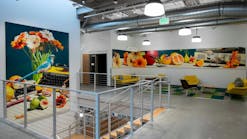LIGHTFAIR, the world’s largest annual architectural and commercial lighting trade show and conference, took place in Las Vegas last week. I wanted to share my thoughts on what I saw that was of the most interest. The 3 main things I saw were: a lot of LED luminaires, more use of optics in products, and lighting controls being present in nearly every booth. To read up more on controls, please see our blogs: “Let’s talk Controls” and “Lightfair International Gets Smart.” I will focus on what I saw in terms of optics and LED luminaires.
When I went to LightFair, I was little unsure of what to expect. There hasn’t been any drastic advancement within the LED technology, so I was a bit nervous to see the same things that I saw last year. However, I was quite impressed with how the lighting manufacturers have started paying more attention to the optics (specifically the secondary optics) in their designs. LED lighting, as most of us know, is notorious for glare since it is an intense point light source. The glare issue is more prominent in the outdoor, architectural, and directional lighting applications. When I think of driving past an LED street light, looking at an LED canopy, or standing under an LED parking light, I can’t say my experience has always been pleasant. The glare from these fixtures is usually quite harsh and deterring. It seems as though in the past designers and manufacturers weren’t paying much attention to the secondary optics. Secondary optics are usually a passing thought because they are a small part of the overall bill of material (cost of optics will vary depending on the application). Also, bringing down the cost of LED products has been such a battle that many times optics cannot get the attention it needs in designs. Though the price of LED lighting is coming down, LED lights are still more expensive than the incumbent technology, so incorporating light diffusers into the product may not always be lucrative. Aside from cost, secondary optics are not heavily incorporated into the design of the products since it decreases the system efficacy (lumens/Watt). However, considering LED component’s high efficacy, it wouldn’t hurt compromising a little on the efficacy if it means getting designs and products that are easy on the eye, literally. Few products at LightFair had such good optics and diffusers that I could look right into them and not blind myself. What was surprising was that sometimes I mistook an LED fixture for halogen or induction lighting. It is good to see that optics are not being completely ignored, and they are being realized as components that are integral for a lighting system to give it its appeal.
There were many great products I saw at LightFair; among them was Osram Sylvania’s Kreios FLx90W flood light: http://www.osram-americas.com/en-us/products/featured-products/Pages/kreios-fl-flx.aspx
The other thing of note that I saw was more LEDs being incorporated into designs of lighting units; however, this trend has been true in nearly every lighting show/conference/trade show for the past few years. Not only were top manufacturers exhibiting mostly LED products with many reporting that 60-80% of their street lighting had now moved to LED, but even mid to smaller sized companies ( < $300 million) exhibited more LED than incumbent lighting products.
Shonika Vijay | Analyst
B.S. in Engineering from the University of California Davis
Shonika Vijay is the analyst for the outdoor and replacement LED market at Strategies Unlimited. She was a consultant in energy efficiency with ADM Associates and DNV KEMA. She conducted evaluation, measurement and verification for utility and state sponsored energy efficiency programs and studies. She completed her Bachelors in Engineering from University of Davis, California





